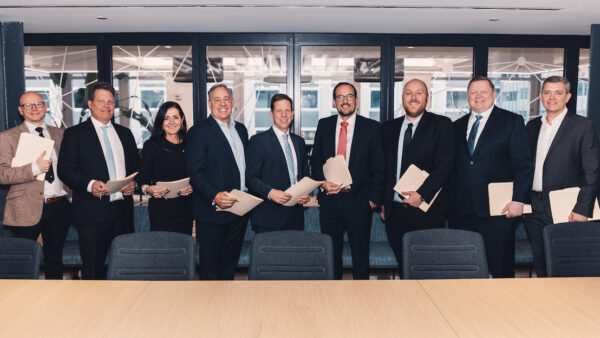British contractor Laing O’Rourke, which aims to be a world leader in off-site construction techniques, has taken a financial hit for its efforts at innovation – but insists it will keep trying.
The third largest UK builder by turnover says its European operations suffered a loss after tax of £53.1m ($81m) thanks to trouble on three unnamed UK contracts delivered with its bespoke Design for Manufacture and Assembly (DfMA) offsite approach.
Significant lessons have been learned from these projects, all of which were secured during the recession– Laing O’Rourke statement
The contracts were hit by “input cost inflation” and delays, leading to losses of £61.2m ($93.4m), the firm said in announcing its results to the year ending 31 March on 3 September.
But group executive chairman Ray O’Rourke (pictured) said the company would not give up, and that a brand new advanced manufacturing facility to be built in England would “revolutionise house-building in the UK”.
Company-wide, Laing O’Rourke recorded profit after tax of £20.1m, down from £41.9m the year before.
But it did well in its “Australia Hub”, which includes Hong Kong, with profit after tax rising to £76.5m from last year’s £43.5m.The company attributed its success in the Asia-Pacific region to “operational focus and discipline”.
The losses in Europe, stemming from first-generation DfMA jobs, were “disappointing”, the company said, but lessons had been learned.
“The Europe Hub results were particularly affected by three first-generation DfMA UK construction contracts, adversely impacted by input cost inflation and delays in delivery using new construction methods,” Laing O’Rourke stated.
It added: “Significant lessons have been learned from these projects, all of which were secured during the recession.”
Laing O’Rourke is unique among the UK’s top contractors in having invested substantially in manufacturing facilities to assemble building components off site to reduce time and scope for error on site.
Last September it completed the £340m Leadenhall Building, a 47-storey steel and glass tower in the City of London (nicknamed the Cheesegrater), of which 85% by value was prefabricated off site.
Although the building caused concern when large bolts began falling off the exterior, it became the UK’s highest-profile example of what can be achieved using prefabricated construction techniques.
Fixing the bolts has been estimated to cost the steel manufacturer, Severfield, £6m.

Eighty-five percent by value of London’s Leadenhall Building, centre, was prefabricated off site by contractor Laing O’Rourke (Credit: Diego Delso/Wikimedia Commons)
Laing O’Rourke has been an innovator since its sensational birth in 2001 when Ray O’Rourke, owner of a prosperous concrete subcontractor, bought the much larger – but ailing – Laing Construction for just £1.
Since then the company has been known for bucking trends, for instance by bringing all construction sub-disciplines back under direct employment, by recruiting high-level expertise from outside the contracting industry, and by funding research at top universities.
In 2012, Laing O’Rourke made the DfMA approach its core delivery methodology. It has invested more than £100m in prefabrication factories, including at its Explore Industrial Park in Steetley, Nottinghamshire.
Now it plans to invest more.
When the company’s results were announced, Ray O’Rourke said that the board had ratified in May this year the final investment decision to build and operate a new advanced manufacturing facility at its Explore Industrial Park.
“The new facility will use intelligent design, precision engineering and fully automated processes to deliver modular solutions that will revolutionise house-building in the UK,” O’Rourke said.
Comments
Comments are closed.











Any form of innovation such as this demands the highest standards which even then may be unachievable! However via trial and very expensive error most industries,no less our very own, can and do make
outstanding progress! The benefits thus derived then far exceed the losses suffered! All praise then to Laing O’Rourke!!
Pre-fabrication isn’t new and it isn’t difficult. To be honest, it’s not even news worthy. Cladding systems, structural steel components, mechanic plant including piping spools. We have been prefabricating these elements for decades or longer. Where it goes wrong is when some bright spark has the politically correct idea of applying these “innovative techniques” where they just don’t belong. I gather from the article above that the off site fabrication giving trouble was the cladding (bolts falling off). That isn’t even worthy of news as I just stated. So what else did they make / are they planning to make off site? Brickwork panels? Now there’s an idea – Yawn.
It is only through the efficiency and rigours of high quality mass production that the supply of housing to meet the urgent demand – and to ‘zero carbon’ standards – are going to be delivered. All the technologies to achieve that are known, and it is to be hoped that Laing O’Rourke lead the way with their new system.
It is impossible to built in the necessary quantity to to those standards in bricks and mortar. So go far it Laing O’Rourke. Show the government that it need not scrap ‘zero carbon’ to achieve its promise of two hundred thousand houses a year.
Pre-fab is laid down, proven and a given; but moving on… LOR needs to invest heavily, and without restraint, in its openly publicised and self-held belief in its deliverability. Belief is 95%, but persuasion is the remaining 5%.